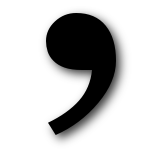- to form possessive nouns
- to show omission of letters (mostly in contractions)
- to indicate plural of lowercase letters
Forming Possessive Nouns
The apostrophe is first used to show possession, or ownership, of nouns:
- Use 's for all singular nouns, even if the noun ends in s!
- my son's book (I have 1 son.)
- Chris's book (Chris ends with s, but he is still 1 person!)
- Use just ' for plural nouns that end in s.
- the girls' bathroom (The bathroom is for multiple girls.)
- my brothers' dog (I have multiple brothers.)
- Use 's for plural nouns that don't end in s.
- my children's toys
- the men's bathroom
- Use 's at the end of compound nouns.
- my mother-in-law's house
- Use 's at the end of a joint ownership
- Curtis and Jessie's car (The car belongs to both Curtis and Jessie.)
- but use 's after each name if you are referring to two separate nouns
- Curtis's and Jessie's shoes (Curtis and Jessie own two separate pairs of shoes.)
Remember that in order to posses or own something, the "owner" must be alive. Things like buildings and furniture are not alive; therefore, you do not need to use an apostrophe:
a vegetable drawer
a chair leg
a hospital bed
Showing Omission of LettersAnother common use for the apostrophe is to show the omission of letters. We see this most commonly in contractions:
do not = don't
I am = I'm
you will = you'll
who is = who's
should have = should've
Other examples of the apostrophe showing omission of letters (or numbers) less common:
government = gov't
1950s = '50s
Indicating Plural of Lowercase Letters
Normally, plural forms of nouns never take an apostrophe:
girl > girls
apple > apples
However, when single, lowercase letters are plural, we use an apostrophe for clarity:
Dot your i's and cross your t's.
I'll be x's and you'll be o's in this game of tic tac toe.
Capital letters, numbers, and other signs do not require the apostrophe:
She has two PhDs.
My father was born in the 1960s.
There are too many &s in your writing.
Common Mistakes
The apostrophe seems simple enough, doesn't it? Here are a few things to remember when using this punctuation mark.
- Possessive pronouns DO NOT take an apostrophe because they already have a possessive meaning.
- his book (NOT his's book)
- This phone is hers. (NOT This phone is her's.)
- Whose paper is this? (NOT Who's paper is this?)
- The government made its decision. (NOT The government made it's decision.)
- a friend of his (NOT a friend of his')
The most difficult of these examples is its vs it's. It's means it is or it has. Its is a possessive pronoun. Practice here.
To learn more about the apostrophe and other punctuation marks, study with us at Nomen Global!

No comments:
Post a Comment